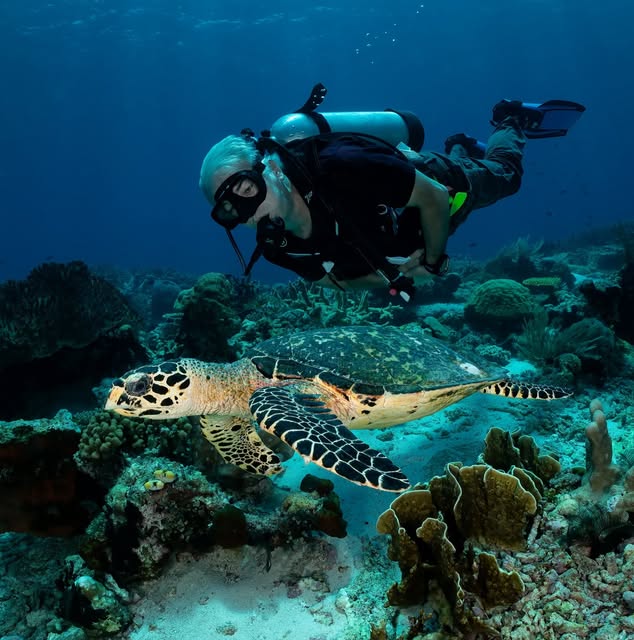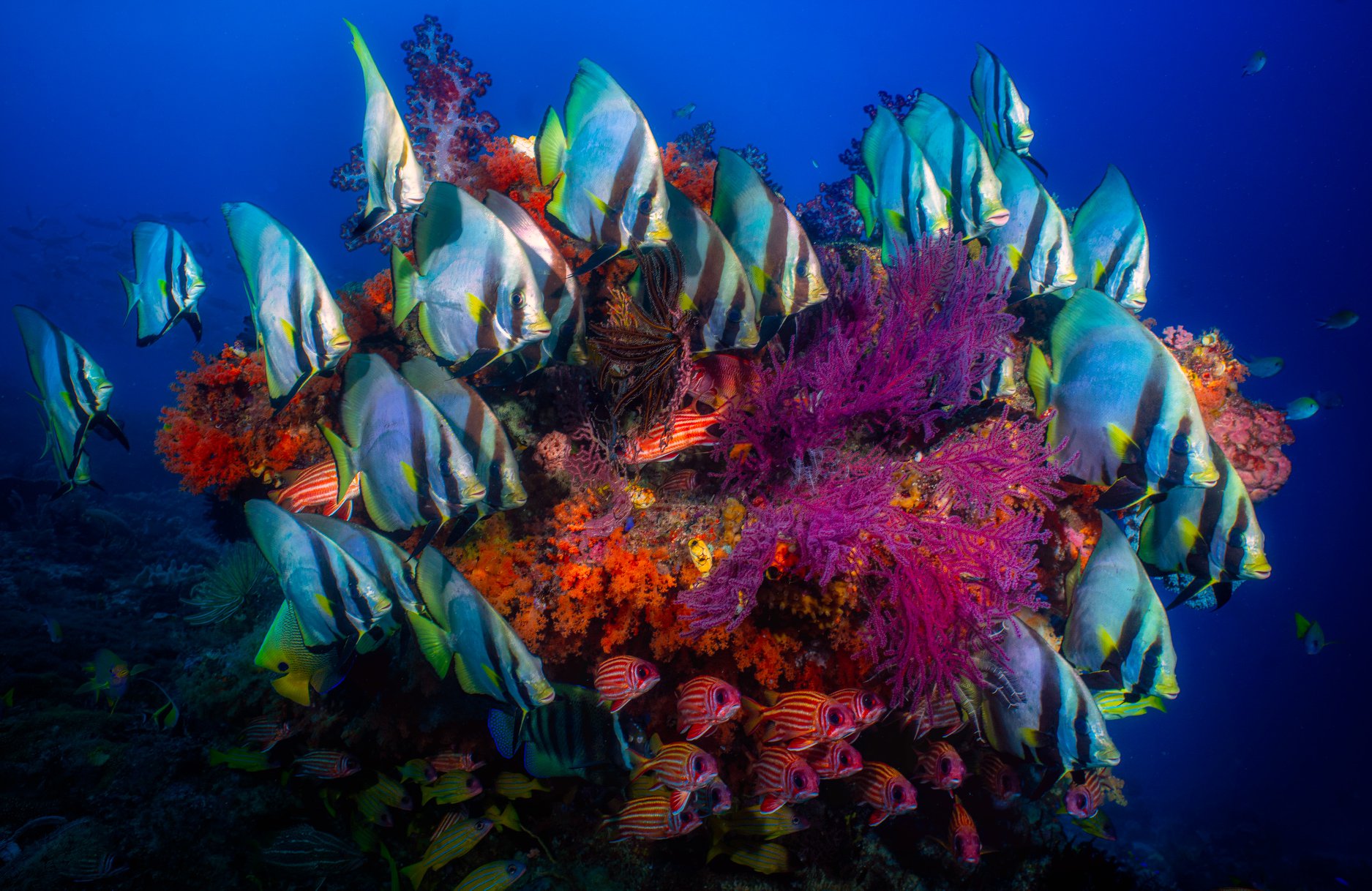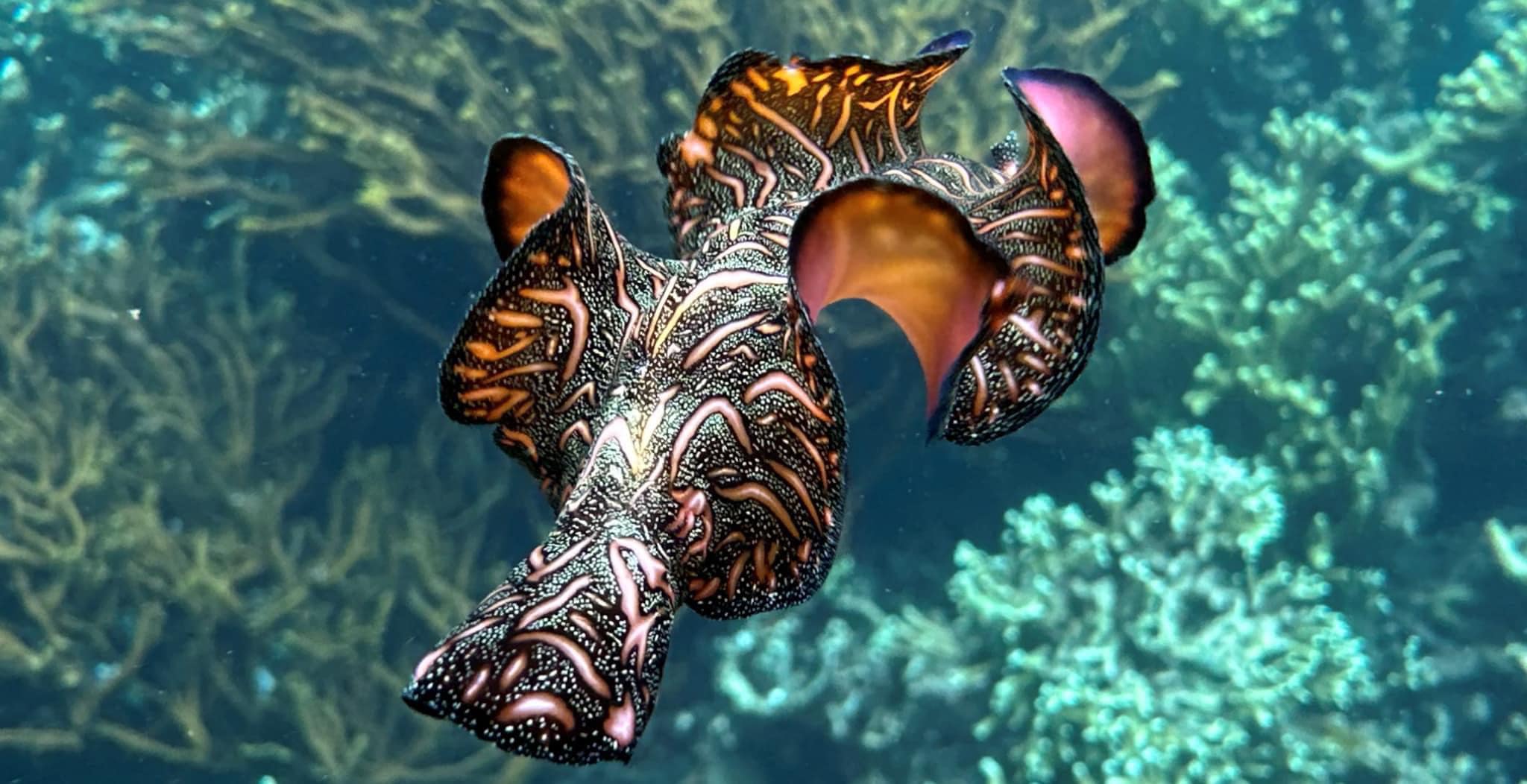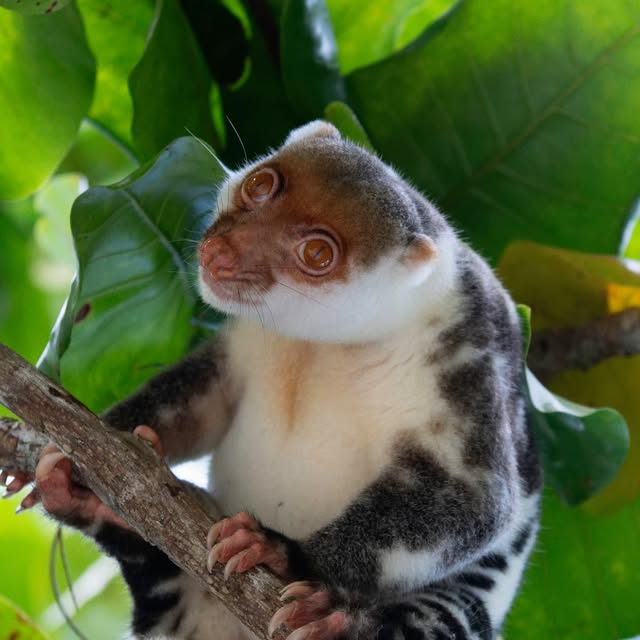Deeply rooted in its local settings, Kri Island is an integral part of Kri Eco Resort. This rustic chic resort is styled with the local tradition, using locally sourced and low-impact materials that are shaped and equipped to sustain the excesses of the natural forces typical of this coastal area and tropical climate.
There’s a total of 13 rooms in 3 categories (four overwater Papuan bungalows, seven stilted water access Superiors and two Deluxe stilted beach cottages). Their no-frills minimal design becomes one with the natural surroundings. Free Wi-fi access is available and all cottages are equipped with hot showers, mosquito netting and electric fans for those still nights when a breeze is not strong enough. Shady pathways meander through the tree line to the open air restaurant which has a laid-back family style atmosphere.
Kri is located in the center of the Raja Ampat Marine park approximately 2 hours from Sorong. This area has been declared a “no take” zone and the reefs in close proximity to the resort are regarded as the best dive sites of Raja Ampat. Less than 1 minute from the resort is the famous ‘Cape Kri’ reef which holds the World’s Record for the highest number of fish species ever counted. The guides, all Papuans, are the most experienced of Raja Ampat. This is their home and they have dived their backyard for many years. Snorkeling and birding are amazing here as well as kayaking. Armed with paddle in hand, you may visit shallow fringing reefs where fish are teeming underneath your kayak. Glide silently through the turquoise waters and visit some remote sandbanks and beaches surrounding the island. The island pace is unhurried…the beaches white…the water azure blue.
With 3 room types to choose from, there is something for everyone. All cottages are built over the water in the traditional Papuan style using local materials to give you a true sense of location. Papuan and Super Cottages offer 1 king (or 2 twin beds), fans and shared bathroom. The family cottage has 1 king and 1 single bed.
Deluxe cabins are waterfront and offer ensuite bathrooms 1 king and 1 single bed, plus fans.
Diving
Put simply, Raja Ampat diving offers some of the best diving in the world. It is the world’s most bio-diverse marine region with more recorded fish, coral and mollusc species than anywhere else on the planet. While staying with us you will experience that the variety of marine life can be staggering. No two islands or islets are alike, and no two dive sites the same. The steep-sided walls of the rocks are shaped by wind and water. Soft, vanilla-colored, sandy bays are ideal for spending time exploring between dives.
Diving and snorkeling conditions in the Dampier Strait are good all year round. The climate of Papua has diffuse seasons with no particular dry or rainy season.
The summer months are windier, some resorts, especially in the south, will close due to rougher conditions. Visibility tends to be the best during this time of the year.
Prime season is October to April. Visibility tends to be influenced by high plankton concentrations that guarantee pelagic encounters. Currents are a constant component and must be considered when planning the dives. Being located that close to the equator and protected by several mountains island masses, we have a kind of microclimate. High humidity and occasional tropical rainfall showers are the standard.
Water temperature is a constant 28 or 29 degrees celcius.
Most guests dive with a 3mm full suit. However Lycras are also worn. This is a personal preference.
Visibility ranges between 15-30 metres.
Because of our protected location we can operate all year around. We count more than 30 sites in closest proximity to the resorts. Here is a pick of some our favorite dive sites.
Cape Kri
One of the favorite dives, Cape Kri is Sordio Bay’s house reef and less than 3 minute by boat from Kri Eco Resort. This is the dive site that put Raja Ampat on the map when Dr Gerry Allen smashed his record for total number of fish species on a single tank dive: 374 different species!
The world-record holding Cape Kri, with a record count of 374 different species in one dive counted by Dr. G. Allen, is just a 1 minute boat ride from our jetty. At the Northeast point of Kri island the currents sweep into a channel between Kri and the small island of Koh. At this point beneath waters churning in the current, huge schools of Big-eye trevallies, Barracudas and Snappers can be seen hanging over the drop-off. At the base of the reef at 38 meters an ancient snagged anchor rests next to a bommie with a dense school of Banded sweetlips. A large shallow coral garden crowns the reef top with blacktip reef sharks patrolling amongst the overlapping maze of hard corals with feeding hawksbill turtles. Car-sized Queensland groupers down to the diminutive ever-present pygmy seahorse can be seen on this phenomenal and always-surprising dive site! Dawn and dusk are feeding time so divers can experience this site at its awe-inspiring best.
Sardines
Only 10 mins from Kri Island, this submerged reef with a reef top at 5 metres, contains a very high biomass, one of the highest in Raja Ampat. Sardines reef is quite simply one of the best reef dives in the world, where divers witness the phenomenal diversity of Raja Ampat at full force. Where the current strikes this offshore reef and splits, a dazzling array of fish congregate, audibly swarming fusiliers spin above, pursued by huge giant trevallies, packs of Bluefin jacks and huge Spanish mackerels. Batfish gather in the hundreds, while multitudes of schooling bannerfish feed in the current. Grey reef sharks, blacktips and whitetips can also be seen along with the wobbegong waiting in ambush on the sea floor. Coral bommies dot the slope covered with many colourful species of dendronephya soft corals and up to three separate species of Pygmy seahorses can be found amongst them. On the current-swept reef top a resident school of thirty massive bumphead parrotfish crunch on the coral, keeping the divers company on a safety stop who hang from their reef-hooks like kites in the wind. Upon surfacing, many divers comment that this is the best dive they have ever done!! Photographers love this dive site and have to return to change from wide angle to macro!
Blue Magic
Only 15 mins from Kri Island, this small pinnacle has almost everything. From Wobbegong sharks to tiny 2cm Denise Pygmy seahorses. The reef top is covered in hard coral with some big coral heads and some tabling Acropora corals well over 3 metres across. There is a resident school of Big eye Trevallies and many large Barracuda. Green Turtles can be found here as well as Black Tips, White Tips and the occasional Grey Reef Sharks. If you are very lucky even a Giant Manta Ray. The magnificent dive ends with a blue water safety stop drifting over and away from the reef.
Manta Sandy
Only 25 mins from Kri Island, this sandy slope is famous for it’s Manta Rays. It is a cleaning station where they come in to get cleaned. If the many reefs are not enough this area also boasts some of the best manta diving in the world! There are two main manta sites just half an hour away. One, Manta Sandy, is a cleaning station where up to 10 mantas can be seen vying for a position above the two rocks where wrasses clean these giants. We get enormous 4 meter wide black mantas, looking like a negative photographic image, their gills are highlighted in white, along with the other more common white-bellied variety. Another site nearby, Manta Slope, mantas circle above in the sun while divers hook onto the reef while the current arcs overhead and down the steep slope below. Divers can be caught unaware while giant demonic-looking black mantas cruise by behind them. This trip is out of our 10km range, but is offered once a week without any fuel surcharges!
The Passage
As seen in many articles, including recently by David Doubilet in the Sept 2007 National Geographic, the passage is completely unique dive site. The narrow canyon 40 minutes away between Gam and Waigeo can be described as river flowing between the two Islands, but also a marine environment, a haven of peculiar and unique microhabitats.
This is a place where experienced divers and photographers enjoy the utterly different experience of diving in this truly one-of-a-kind location. Above water the sheer limestone cliffs make this a place where the sightseeing above water is also excessively beautiful. Guests combine this trip visiting the labyrinthine Hidden Bay, a maze of towering islets, and Kabui Bay where literally hundreds of mushroom islands create staggering scenery. This trip is out of our 10km range but is offered once a week without any fuel surcharges!
Armed with paddle in hand, visit shallow fringing reefs where fish are teeming underneath your kayak. Glide silently through the turquoise waters and visit some remote sandbanks and beaches surrounding the island. We also have a limited number of SUPs (Stand-up paddle boards) at your disposal.
Kayak 4 Conservation is a community based initiative founded by Papua Diving in order to support local economy.
The partnership with the local homestays directly supports those communities and helps them to participate in sustainable tourism by supporting them with setting up their own little business. A series of locally owned guest houses have been selected to welcome sea kayakers to relax and spend the nights, without hauling around any large camping gear.
Honoring our founding vision, the fiberglass team is composed of four Papuans, which were offered an alternative livelihood by building these kayaks. Kayak4conservation and RARCC’s mission, is to serve as a development institution for local people of Raja Ampat’s archipelago is home to an amazingly diverse flora and fauna.
Visit the RARCC (Raja Ampat Research & Conservation centre) adjunct to Sorido Bay Resort.
Take a break from the ocean and be amazed by the variety of wildlife on land.
Furry marsupials
The cutest inhabitants of the island are propably the Cuscuses. These furry marsupials are nocturnal and can often be spotted during dinnertime when they come to visit the restaurant or walk along the rooftops trying to steal a banana which they love eating. If you are lucky you may even encounter our domestic Tree kangaroo “Stinky”.
Home to many birds.
From Lorikeets, Eclectic parrots, Kookaburras and Paradise Kingfishers to Glossy mantled manucodes and Cockatoos – all live on Kri. Don’t forget to bring walking shoes, your binoculars and – of course – your camera.
Flower Power
Kri grounds are covered with wild orchids. Several species are to be found during a walk on the island.
Lizards
Monitor lizards are widely found on the island. Although they might look a bit unfriendly, they are very shy and absolutely not dangerous. Often you can find them along the walkways or just watch them sunbathing on the beach.
Coconut crabs
Although listed as endangered species, they are still abundant on Kri Island. Nocturnal by nature they will only come out at nightime to feed on coconuts. It is hard to believe, but among the closest relatives of this massive crustacean is the itsy, bitsy, teeny, tiny hermit crab. Don’t believe it? Take a closer look at a little hermit crab and it looks a lot like its larger cousin … only smaller, of course.
Birdwatching excursion
This cruise is undertaken every saturday just before sunset or in the afternoon. We will visit a small neighbouring village by boat (30 min boat trip) followed by 30 minute hike to the birding location to see the endemic Red Bird of Paradise. This trip is complementary (free boat transfer to starting point of the start of the 30 minute hike to the birding location) however each participant is kindly requested to leave a donation to protect the birds and assist in local healthcare initiatives. Bring binoculars and walking shoes! Different birdwachting excursions are possible upon special request.
Kri donates 10% of its profit to support local communities and conservation initiatives. They also employ more local Papuan people than any other operator which makes about 90% of the staff local Papuans.
The RARCC Foundation
Being the pioneers who have been diving the Raja Ampat for over 20 years, we hired local people from day one. We created an alternative for destructive livelihood gathering. Several of our staff have been involved in illegal logging, blast fishing, shark finning and turtle poaching before. They were offered new positions in our team. Their experience helps us understand and counter these problems.
The RARCC Foundation aims to:
• Protect and preserve the natural heritage of the Raja Ampat archipelago
• Encourage, assist and facilitate research on the flora and fauna
• Combat poverty among the local population
* Teaching the local community member in sustainable use of their natural resources
• Promoting green awareness among the local population
• Assist the local population to work in sustainable tourism
Promote the Raja Ampat to actively engage more institutions, companies and individuals with similar goals to work together in this unique area
Kayak for Conservation
The partnership with the local homestays directly supports those communities and helps them to participate in sustainable tourism by supporting them with setting up their own little business. A series of locally owned guest houses have been selected to welcome sea kayakers to relax and spend the nights, without hauling around any large camping gear.
To see more about the kayaking trips, watch this VIDEO